Highlights from HPLC 2016
LCGC North America
HPLC 2016, chaired by Professor Robert Kennedy, was held June 19–24 in San Francisco, California, at the Marriott San Francisco Marquis. This installment of "Column Watch" covers some of the highlights observed at the symposium including stationary-phase developments, particle technology, and areas of growing application of HPLC. In addition, trends and perspectives on future developments in HPLC noted from the conference are presented.
The 44th International Symposium of High Performance Liquid Phase Separations and Related Techniques (HPLC 2016), chaired by Professor Robert Kennedy, was held June 19–24 in San Francisco, California, at the Marriott San Francisco Marquis. This installment of “Column Watch” covers some of the highlights observed at the symposium, including stationary-phase developments, particle technology, and areas of growing application of high performance liquid chromatography (HPLC). In addition, trends and perspectives on future developments in HPLC noted from the conference are presented.
The 44th International Symposium of High Performance Liquid Phase Separations and Related Techniques (HPLC 2016), convened June 19–24 in San Francisco, California, at the Marriott San Francisco Marquis Hotel and Conference Center. This was the fourth time the conference was held in San Francisco (also in 2006, 1996, and 1986-notice a trend?). HPLC 2016, which has grown into the premier event bringing together leading scientists in the field of liquid chromatography and related techniques, attracted 1007 delegates from numerous countries. The attendance was a considerable increase compared to HPLC 2014 in New Orleans, Louisiana, but similar in numbers to previous European events. HPLC 2016 was chaired by Professor Robert Kennedy of the University of Michigan. As noted by Kennedy, the program was grouped into three main areas: “Improving Separations,” which was devoted to new technology and theory; “Making Discoveries,” which was concerned with applications of separation science; and “Harnessing the Power,” which centered on hyphenation of liquid separations with mass spectrometry (MS). Professor Kennedy also noted that because of inspiration regarding advances in personalized medicine, aspects of proteomics, metabolomics, and pharmaceutical analyses were emphasized.
About 180 oral presentations, including several plenary lectures, were featured within the conference. There were also numerous poster presentations and several short courses, vendor seminars, and tutorials within the program. This installment of “Column Watch” reports on highlights and trends observed at the conference.
Highlights and Trends
Over the past few years the articles highlighting topics at the HPLC symposium have listed the main topics covered and contrasted these with previous years. This year several colleagues present at the symposium were asked what struck them as most interesting. The following is a synopsis of their responses along with some personal views.
Three-Dimensional Printing Applied to Separations Technology
Falling under the label of “improving separations,” the most cited of the exciting advances noted at the conference centered on three-dimensional (3D) printing of high performance liquid chromatography (HPLC) columns. Simone Dimartino, from the University of Edinburgh, presented a talk entitled “3D Printing of Chromatography Media: Closing the Loop between Real World Experiments and Computer Simulations” (1). On the basis that the column walls are the ultimate problem in column packing, the idea presented was to 3D print half spheres of particles into the walls of the columns to eliminate, or at least minimize, wall effects. Dimartino was awarded with the Csaba Horváth Young Scientist Award. As another sign of the excitement surrounding the 3D concept, Vipal Gupta of the University of Tasmania was awarded first prize in the “Best Poster Award” contest for his effort entitled “3D Metal Printed Miniaturized Chromatographic Columns” (2). A quick survey of recent literature indicates that 3D printing of microdevices for liquid handling, interfacing various devices, and, in some cases, separations is gaining momentum. It will be interesting to see where this concept can take separations in the future.
Advances in Superficially Porous Particle Technology-Applications to Large-Molecule Separations
Another common observation among our colleagues was the continuing focus and advances in superficially porous particle (SPP) technologies. Wu Chen of Agilent Technologies presented a paper entitled, “Comparison of Optimized Wide Pore Superficially Porous Particles (SPPs) Synthesized by One-Step Coating Process with Other Wide Pore SPPs for Fast and Efficient Separation of Large Biomolecules” (3). Chen described several processes for the manufacture of SPPs, including “layer-by-layer” as well as “coacervation” (Figure 1). Chen went on to compare the impact of pore size, shell thickness, and particle size on resolution in large-molecule separations and determined that pore size provides the largest impact on chromatographic performance. Chen then described application results comparing several differing surface chemistries built on 3.5-µm, 450-Å SPPs exhibiting a 3-µm core diameter and a 0.25-µm shell thickness. Figure 2 shows a comparison of retention and resolution for a set of protein standards on several different chemical modifications of the 3.5-µm, 450-Å SPPs. More details can be found in reference 4.
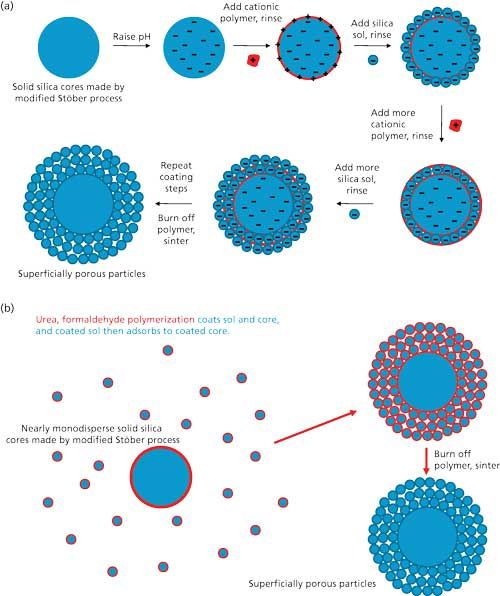
Figure 1: Processes for the preparation of superficially porous particles: (a) layer by layer approach, (b) coacervation. Adapted with permission from reference 3.
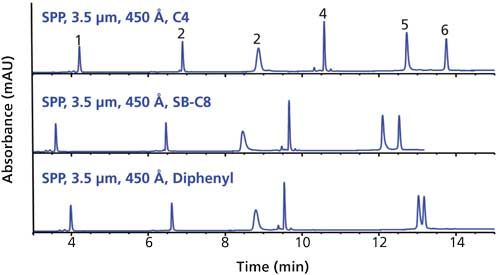
Figure 2: Different selectivity of a protein standard. Column dimensions: 100 mm x 2.1 mm; gradient: A: 0.1% trifluoroacetic acid in water, B: 0.1% trifluoroacetic acid in acetonitrile, 20–50% B in 15 min, 3-min wash at 95% B, 2-min re-equilibration at 20% B; flow rate: 0.3 mL/min; temperature: 60 °C; detection: UV absorbance at 220 nm; injection volume: 5 µL. Peaks: 1 = ribonuclease A (14 kDa), 2 = cytochrome C (12 kDa), 3 = holo-transferrin (80 kDa), 4 = α-lactalbumin (14 kDa), 5 = catalase (240 kDa), 6 = carbonic anhydrase (30 kDa). Adapted with permission from reference 3.
In a similar manner, Barry Boyes of Advanced Materials Technologies described the development of an SPP with a 2.7-µm particle size and a pore diameter of 1000 Å (5). Using several experiments comparing the large-pore SPP to both fully porous particles (FPPs) and other SPPs with smaller pore diameters, Boyes demonstrated significant advantages of the larger pore size for large-molecule analyses. He went on to conclude that SPPs with enlarged pore sizes (400 and 1000 Å) have particular utility for protein analyses, are highly robust, and allow faster protein separations with higher efficiency. He also posed the question, “Is there any disadvantage to the use of the largest feasible pores for generic protein separations?” In addition to the discussion on the advantages of large pore structures for large-molecule separations, Boyes also presented compelling data for the use of difluoroacetic acid in place of the more common trifluoroacetic acid and formic acid in large-molecule separations. Trifluoroacetic acid generally provides improved chromatography, but has the drawback of causing ion suppression when using MS for detection. Formic acid, on the other hand, is MS friendly, but often produces poorer peak shapes for large molecules. Boyes pointed out through comparisons that difluoroacetic acid provides a suitable compromise between the two extremes. Figure 3 shows a comparison of chromatographic results obtained for a monoclonal antibody (mAb) using formic acid, difluoroacetic acid, and trifluoroacetic acid as mobile-phase modifiers. As shown, the difluoroacetic acid provides peak shapes that rival those obtained using trifluoroacetic acid.
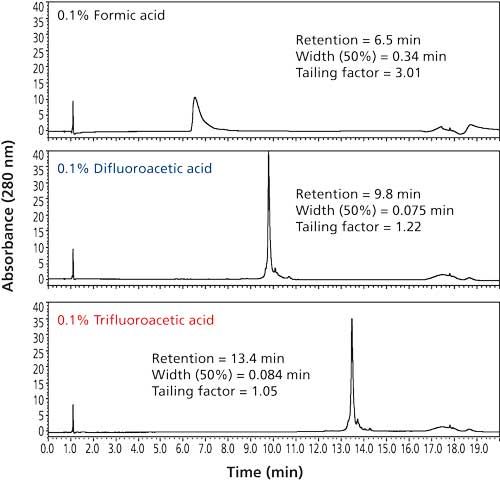
Figure 3: Mobile phases for improved mAb LC. Column: 150 mm x 2.1 mm Halo Protein 400 C4; gradient: 28–38% acetonitrile–0.1% acid as indicated over 15 min. Flow rate: 0.3 mL/min; temperature: 80 °C; sample volume: 2 µL of Intact SILu Lite SigmaMAb (0.5 µg/µL in water). Adapted with permission from reference 5.
Hydrophobic interaction chromatography (HIC) is often a valuable tool used to separate polar variants of proteins. HIC, however, uses high concentrations of nonvolatile buffers, rendering it incompatible with MS detection. In a paper presented by Andrew Alpert of PolyLC Inc., he described efforts to render HIC MS friendly (6). Using more-hydrophobic analogs of the commercially available poly(propyl aspartamide) stationary phase, Alpert demonstrated that proteins could be eluted in MS-friendly (or friendlier) mobile phases that may lead to a possible marriage of the two techniques. Alpert went on to show that the resulting chromatography is not exactly HIC or reversed-phase liquid chromatography, but a useful hybrid of the two modes. Initial sample loading is accomplished at 0.7–1 M ammonium acetate conditions and elution takes place by decreasing the salt concentration and increasing the concentration of acetonitrile.
High-Speed Chromatography
Professor Dan Armstrong of the University of Texas at Arlington presented data on very fast chiral and achiral separations in his talk entitled “Practice and Consequences of Ultra-Fast, High Efficiency Achiral and Chiral Separations” (7). Armstrong reported routinely completing separations in 30–60 s using some traditional and novel phases built on modern superficially porous and highly efficient sub-2-µm fully porous particles. An example of achiral separations is presented in Figure 4 where difficult-to-separate desfluoro analogs are separated from their respective parent molecules in under 60 s. Armstrong described this as an important achievement because many pharmaceutical drugs now contain labile fluorine atoms within their structures. Upon comparing brush-type phases bonded to 2.7-µm SPPs against commercially available 5-µm columns of the same chemistry, Armstrong obtained 20–40% higher resolution under the same mobile phase conditions with 40–70% faster elution times and 2–5 times more efficiency. Under isoelutropic conditions the SPP phases generate nearly 70% greater resolution. Armstrong went on to say that the effects are even greater at higher linear velocities. Similar results were reported for chiral stationary phases (CSPs) built on efficient sub-2-µm phases. Armstrong also pointed out in his lecture that instruments, even modern ultrahigh-pressure liquid chromatography (UHPLC) systems, still need to be modified to produce the best results.

Figure 4: Ultrafast separation of ezetimibe, ciprofloxacin, ofloxacin, and their desfluoro analogues. (a) Column: 5 cm x 0.46 cm Hydroxylpropyl-β-cyclodextrin SPP; mobile phase: 50:50 5 mM ammonium acetate (pH 4.0)–methanol; flow rate: 2.0 mL/min. (b) Column: 15 cm x 0.46 cm CF6 SPP; mobile phase: 90:10:0.3:0.2 acetonitrile–methanol–trifluoroacetic acid–trimethylamine; flow rate: 4.5 mL/min. (c) Column: 15 cm x 0.46 cm CF6 SPP; mobile phase: 90:10:0.3:0.2 acetonitrile–methanol–trifluoroacetic acid–trimethylamine, flow rate: 4.5 mL/min. Adapted with permission from reference 7.
There were several other interesting talks related to high-speed separations, including “New Developments in Fast Chromatography for Supporting Pharmaceutical Process Research,” where Erik Regalado of Merck Research Laboratories presented a compelling case for the need for speed in pharmaceutical research (8). John Engen of Northeastern University demonstrated fast UHPLC separation of peptides in his talk entitled “Peptide Separations in Short Times and Low Temperature at 15,000 psi” (9). In another interesting talk, Attila Felinger of the University of Pecs used monolithic column constructs to examine the impact of frits on column efficiencies (10). Felinger demonstrated that for early eluted compounds, monolithic columns demonstrated significantly better performance than packed bed columns; however, when frits were added to the monolithic columns, the performance was similar. The study provides evidence that the frits used to maintain particles within the column may contribute to inefficiencies.
Multidimensional Separations
Similar to last year’s meeting, there was extensive interest in developments in multidimensional chromatography (two-dimensional [2D] liquid chromatography [LC]). With three separate sessions dedicated to the technique, attention seemed even greater this year. The most apparent difference to past years was that industry is beginning to utilize the technology. For example, Samuel Yang of Genentech presented an interesting lecture entitled “Method Validation of a Two-Dimensional Liquid Chromatography Quality Control Method for Pharmaceutical Materials: A Focus on Special Considerations Unique to 2D-LC Method Qualification” (11). Likewise, Kelly Zhang, also of Genentech, spoke about the use of 2D-LC in both small molecule and conjugated antibody drugs (12). From these talks it is apparent that the technique is making its way into the real world. Multidimensional separations will likely continue to grow within the pharmaceutical industry, especially in complex large molecule separations.
Another approach toward multidimensional separations was discussed by Professor Gerard Hopfgartner of the University of Geneva (13). Hopfgartner, who is well known in the MS world, discussed the coupling of liquid chromatography with differential ion mobility (DMS) mass spectrometry. In ion mobility MS, ions can be separated based on their mobility in a carrier gas. Ion mobility is dependent on applied field strengths that may be varied. This property is taken advantage of in DMS. Hopfgartner presented several examples of improved separations of small molecules and investigated the use of organic additives to the transport gas. He also noted that gas-phase separations take place on a faster time scale than liquid-phase separations and therefore provide a more perfect marriage than, perhaps, 2D-LC. There have been many improvements in ion mobility analyzers over the past decade that may stimulate additional growth of the technique within the separation science community.
Ion Chromatography
Another talk that was cited several times by our colleagues was presented by Farooq Wahab of the University of Texas at Arlington (14). The main idea of Wahab’s talk was that it is easy to predict whether a given analyte will front or tail under column overload conditions on ion chromatography columns as well as for most modes of liquid chromatography. The rule he described is simple: If the mobile-phase components have higher affinity toward the stationary phase than the analyte, the peaks will front under overload conditions. If the mobile-phase components have lower affinity toward the stationary phase than the analyte, the peaks will always tail. Wahab also pointed out that an ion-exchange column can have more than one kind of charged site, each with different kinetics for ion exchange.
Hydrophilic-Interaction Chromatography
Hydrophilic-interaction chromatography (HILIC) was once again a highly discussed topic at the HPLC meeting. In a quick perusal of the conference proceedings, 31 separate talks, tutorials, and posters were observed relating to developments and applications in HILIC. The desire to understand more about HILIC was obvious from the number of colleagues that attended the tutorial on Tuesday entitled “Understanding Separations in HILIC Chromatography: Theory to Practice” (15). Ron Orlando of the University of Georgia presented a talk he titled “Predicting the HILIC Retention Behavior of Glycans, Glycopepetides and other Modified Peptides” (15). Orlando pointed out that there is now enough information to be able to predict retention of glycans based on their structure. Furthermore, retention characteristics of unknown glycans can be used to predict structure. He went on to describe the same for glycopeptides and that the ability to determine glycans, while attached to peptide backbones, enables site-specific glycan determination.
Poster Presentations
Poster presentations are a vital component of the HPLC symposia. This fact is evidenced by the numerous posters that were presented at HPLC 2016. The tradition of Best Poster Award, sponsored by Agilent Technologies, at HPLC conferences continued in San Francisco. There were 273 poster entrants in 24 session topics, and 43 of our colleagues devoted a great deal of their time to review the posters. Each poster was evaluated for inspiration (novelty and originality), scope (amount of work, technical quality, and execution of the experiments) and presentation (clarity, readability, and author’s explanation). The nominations were eventually whittled down to 10, and eight reviewers evaluated these to select the final awardees. These 10 finalists, who were presented with their awards by Monika Dittmann of Agilent Technologies on the last day of the symposium, are listed in Table I. Congratulations to all those nominated.

Conclusions
HPLC 2016 was again an eventful symposium bringing together researchers interested in separation science from around the globe. The 2015 meeting was described as evolutionary rather than revolutionary (16). The same can be said of the 2016 meeting as most of the presentations provided information on steps forward for existing technologies and the coupling of multiple existing techniques to meet the challenges of complex separations. There were, however, a few exceptions. The idea that HPLC columns could be 3D printed is an exciting new reality. The adoption of traditionally academic techniques by industry such as 2D-LC further indicates significant changes in the practice of HPLC. As with HPLC 2015, there was an evident trend toward a focus on large-molecule separations. It is expected that this trend will continue and result in many new developments in liquid separation technologies.
Upcoming Meetings
The 45th International Symposium of High Performance Liquid Phase Separations and Related Techniques will be chaired by Michal Holcapek and Frantisek Foret and held June 18–22, 2017, in Prague, Czech Republic.
The 46th International Symposium of High Performance Liquid Phase Separations and Related Techniques will be chaired by Doo Soo Chung and held November 5–9, 2017, in Jeju, South Korea.
Acknowledgments
Coverage of such a large symposium is impossible without a great amount of assistance. The author would like to acknowledge the invaluable assistance from Dr. Wu Chen and Dr. Xiaoli Wang (Agilent Technologies), Professor Dan Armstrong, and Dr. Barry Boyes (Advanced Materials Technology) for their kind permission to print representations from their talks. In addition, the author would also like to thank Professor Dwight Stoll (Gustavus Aldophus College), Dr. Andrew Alpert, Professor Ron Orlando, Professor James Jorgenson (University of North Carolina), Professor Gerard Hopfgartner, Professor Attila Felinger, Professor Oliver Trapp (Ruprecht-Karls-University Heidelberg), Dr. Farooq Wahab, Professor David McCalley (University of the West of England), Mr. Timothy Langlois (Advanced Materials Technology), Professor Deirdre Cabooter (University of Leuven), Dr. Monika Dittmann, and Professor Gert Desmet (Vrije Universiteit Brussel) for providing notes, insights, and discussions regarding the content of various sessions.
References
- S. Nawada, F. Dolamore, C. Fee, and S. Dimartino, “3D Printing of Chromatography Media: Closing the Loop between Real World Experiments and Computer Simulations,” presented at the 44th International Symposium of High performance Liquid Phase Separations and Related Techniques (HPLC 2016), San Francisco, California, 2016.
- V. Gupta, M. Talebi,S. Beirne, P. Nesterenko, G. Wallace, and B. Paull, “3D Metal Printed Miniaturized Chromatographic Columns,” presented at the 44th International Symposium of High Performance Liquid Phase Separations and Related Techniques (HPLC 2016), San Francisco, California, 2016.
- W. Chen, A. Mack, and X. Wang, “Comparison of Optimized Wide Pore Superficially Porous Particles (SPPs) Synthesized by One-Step Coating Process with Other Wide Pore SPPs for Fast and Efficient Separation of Large Biomolecules,” presented at the 44th International Symposium of High performance Liquid Phase Separations and Related Techniques (HPLC 2016), San Francisco, California, 2016.
- W. Chen, K. Jiang, A. Mack, B. Sachok, X. Zhu, W.E. Barber, and X. Wang, J. Chromatogr. A.1414, 147–157 (2015).
- B. Boyes, B. Wagner, S. Schuster, W. Miles, and J. Kirkland, “Improving Superficially Porous Particles for Larger Protein Separations,” presented at the 44th International Symposium of High Performance Liquid Phase Separations and Related Techniques (HPLC 2016), San Francisco, California, 2016
- A. Alpert, “A Series of New Materials for Direct HIC-MS Analysis of Proteins in Top-Down Proteomics,” presented at the 44th International Symposium of High Performance Liquid Phase Separations and Related Techniques (HPLC 2016), San Francisco, California, 2016.
- D. Armstrong, “Practice and Consequences of Ultra-Fast, High Efficiency Achiral and Chiral Separations,” presented at the 44th International Symposium of High Performance Liquid Phase Separations and Related Techniques (HPLC 2016), San Francisco, California, 2016.
- E. Regalado, K. Zawatzky, and C. Welch, “New Developments in Fast Chromatography for Supporting Pharmaceutical Process Research,” presented at the 44th International Symposium of High Performance Liquid Phase Separations and Related Techniques (HPLC 2016), San Francisco, California, 2016.
- T. Wales and J Engen, “Peptide Separations in Short Times and Low Temperature at 15,000 psi,” presented at the 44th International Symposium of High Performance Liquid Phase Separations and Related Techniques (HPLC 2016), San Francisco, California, 2016.
- N. Lambert, N. Tanaka, and A. Felinger, “The Performance of Columns for Fast Liquid Chromatography,” presented at the 44th International Symposium of High Performance Liquid Phase Separations and Related Techniques (HPLC 2016), San Francisco, California, 2016.
- S. Yang, J. Wang, B. Scott, and K. Zhang, “Method Validation of a Two-Dimensional Liquid Chromatography Quality Control Method for Pharmaceutical Materials: A Focus on Special Considerations Unique to 2D-LC Method Qualification,” presented at the 44th International Symposium of High Performance Liquid Phase Separations and Related Techniques (HPLC 2016), San Francisco, California, 2016.
- K. Zhang, “Multi-Dimensional LC: Navigating the Chromatographic Space from Small Molecules to Conjugated Antibody Drugs,” presented at the 44th International Symposium of High Performance Liquid Phase Separations and Related Techniques (HPLC 2016), San Francisco, California, 2016.
- M. Raetz, R. Picenoni, G. Boehm, and G. Hopfgartner, “LC-SWATH/MS Metabolomics Platform with Hyphenation of Extraction and Analysis of Polar and Non-Polar Metabolites in Plasma and Urine,” presented at the 44th International Symposium of High Performance Liquid Phase Separations and Related Techniques (HPLC 2016), San Francisco, California, 2016.
- M.F. Wahab, C.A. Lucy, and M.K. Pappoe, “Peaks Behaving Badly: Overload Behavior in Ion Chromatography,” presented at the 44th International Symposium of High Performance Liquid Phase Separations and Related Techniques (HPLC 2016), San Francisco, California, 2016.
- D.S. Bell, “Understanding Separations in HILIC Chromatography: Theory to Practice,” presented at the 44th International Symposium of High Performance Liquid Phase Separations and Related Techniques (HPLC 2016), San Francisco, California, 2016.
- R. Orlando, M. Badgett, and B. Boyes, “Predicting the HILIC Retention Behavior of Glycan, Glycopeptides and Other Modified Peptides,” presented at the 44th International Symposium of High Performance Liquid Phase Separations and Related Techniques (HPLC 2016), San Francisco, California, 2016.
- D.S. Bell and X. Wang, LCGC North Am. 33(9), 682–693 (2015).
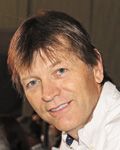
David S. Bell is a manager in pharmaceutical and bioanalytical research at MilliporeSigma (formerly Sigma-Aldrich/Supelco). With a B.S. degree from SUNY Plattsburgh and a PhD in Analytical Chemistry from The Pennsylvania State University, Dave spent the first decade of his career within the pharmaceutical industry performing analytical method development using various forms of chromatography and electrophoresis. During the past 15 years, working directly in the chromatography industry, Dave has focused his efforts on the design, development, and application of stationary phases for use in HPLC and hyphenated techniques. In his current role at MilliporeSigma, Dr. Bell’s main focus has been to research, publish, and present on the topic of molecular interactions that contribute to retention and selectivity in an array of chromatographic processes. Direct correspondence to: LCGCedit@ubm.com
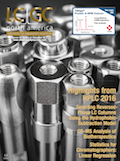
Extracting Estrogenic Hormones Using Rotating Disk and Modified Clays
April 14th 2025University of Caldas and University of Chile researchers extracted estrogenic hormones from wastewater samples using rotating disk sorption extraction. After extraction, the concentrated analytes were measured using liquid chromatography coupled with photodiode array detection (HPLC-PDA).
Polysorbate Quantification and Degradation Analysis via LC and Charged Aerosol Detection
April 9th 2025Scientists from ThermoFisher Scientific published a review article in the Journal of Chromatography A that provided an overview of HPLC analysis using charged aerosol detection can help with polysorbate quantification.
Removing Double-Stranded RNA Impurities Using Chromatography
April 8th 2025Researchers from Agency for Science, Technology and Research in Singapore recently published a review article exploring how chromatography can be used to remove double-stranded RNA impurities during mRNA therapeutics production.







